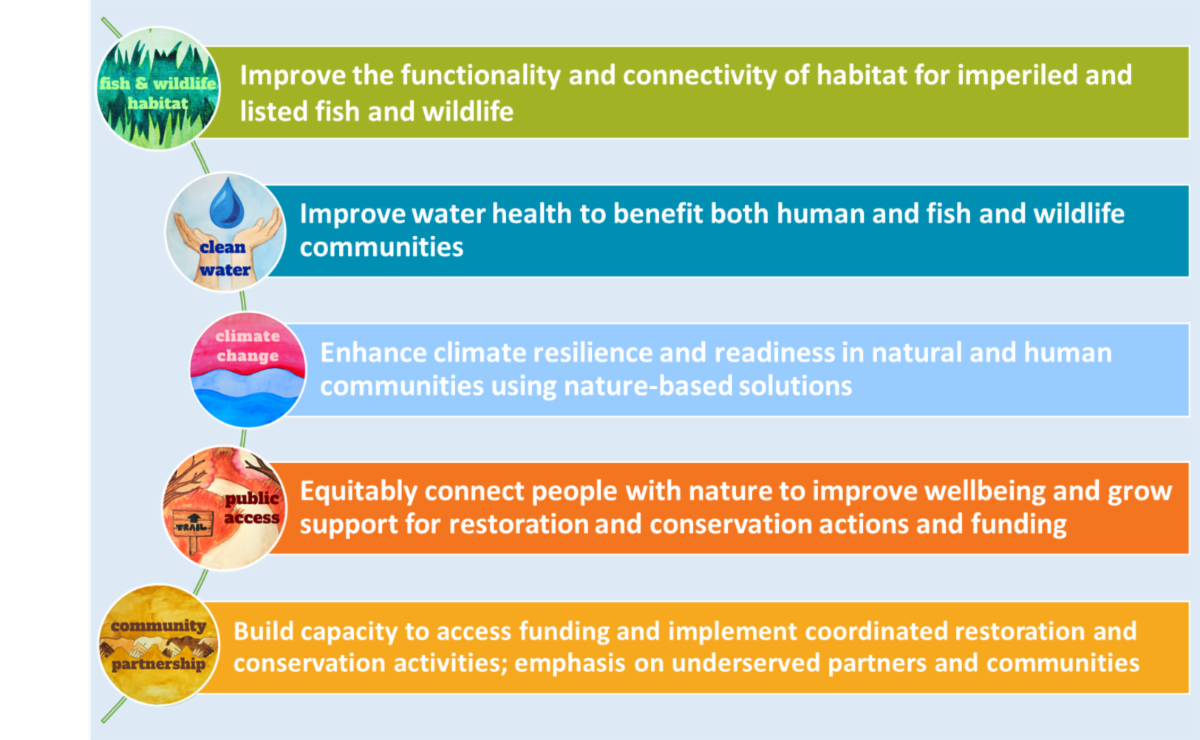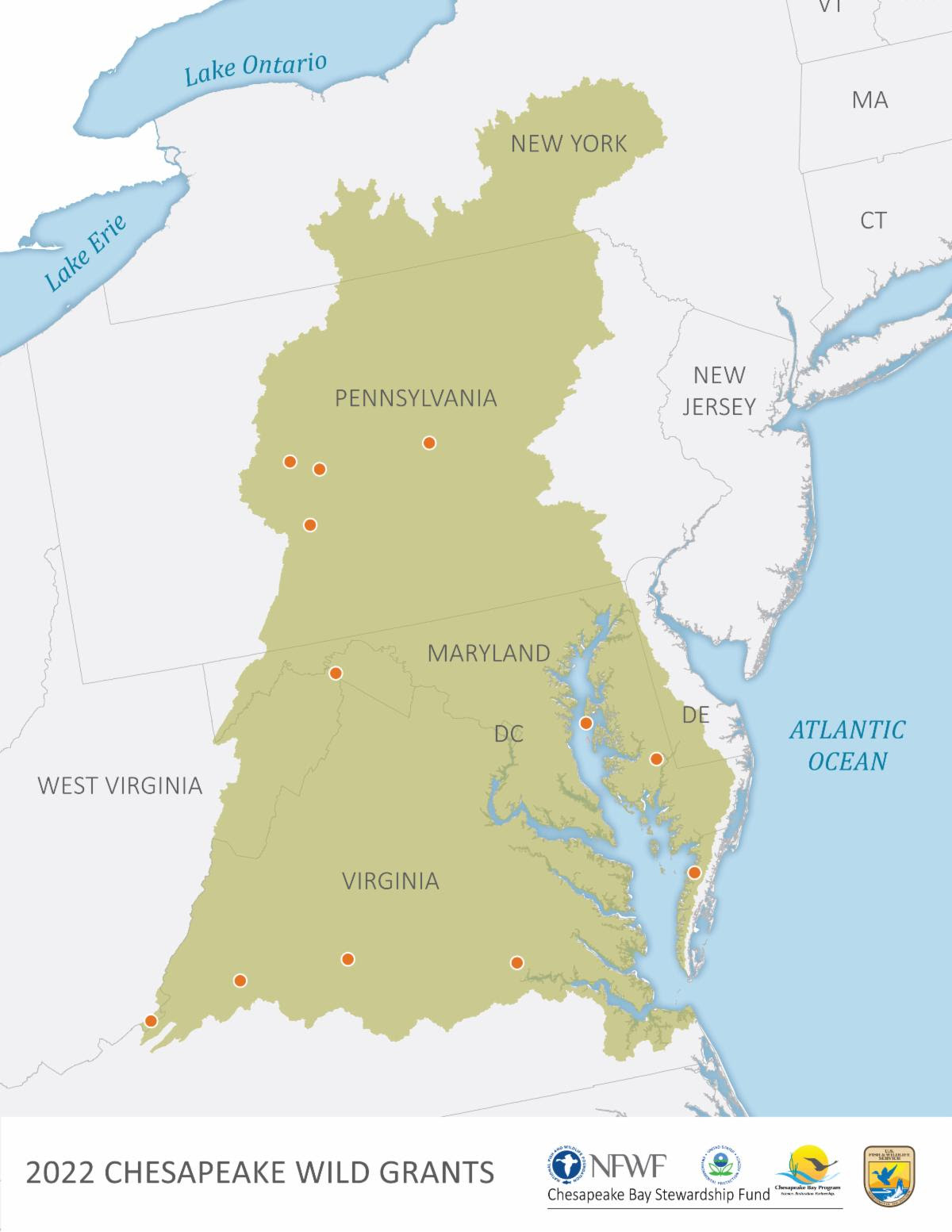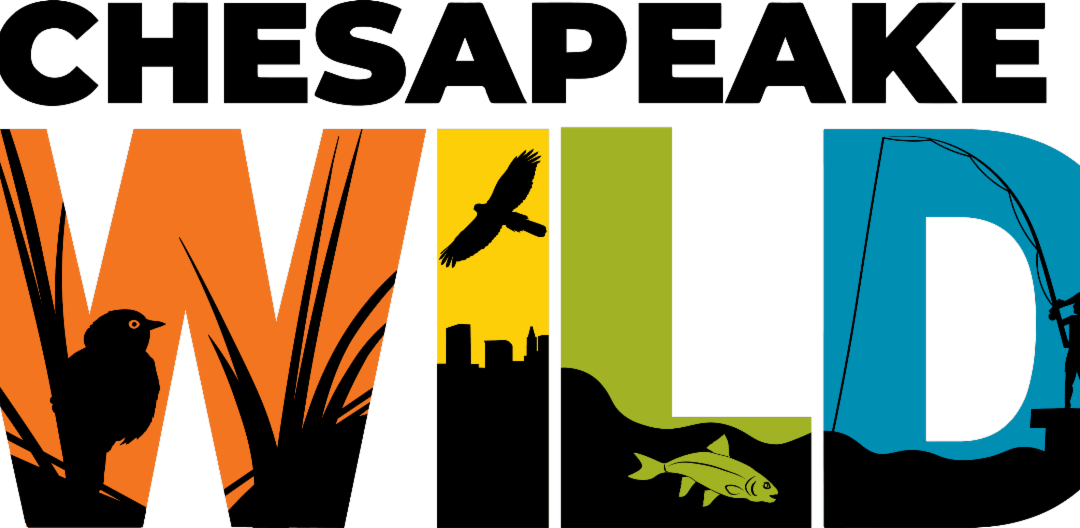The new Chesapeake WILD Logo
Written by Mike Bonnell
This year US Fish and Wildlife Service (FWS or Service) joined Chesapeake Conservancy and National Park Service as co-conveners of the Chesapeake Conservation Partnership (CCP). As part of this enhanced partnership, the CCP is continuing its support for the Chesapeake Watershed Investments for Landscape Defense (WILD) Program. Chesapeake WILD, as both a grant funding program and a conservation network, is a vital part of CCP’s strategy to conserve 30% of the Chesapeake Bay watershed by 2030. And the strategy is about more than just protecting 30% of the landscape, too – it also means attending to the needs of fish, wildlife and people who use it by supporting proper conservation, restoration, recreation and stewardship practices on the land. WILD can fund all of these, ensuring that important landscape and ecosystem functions will endure far into the future. In this first of two Lightning Updates discussing Chesapeake WILD, we review the program itself and its past successes as we look to the future. Readers can also learn about our new summer intern’s project investigating how equitable practices can be more effectively integrated into the program.
In 2020, the Chesapeake WILD program was created when Congress passed America’s Conservation Enhancement Act. Enabling legislation directs the Service to develop a watershed-wide strategy that supports the implementation of a shared set of science-based restoration and protection activities through cost-effective projects with measurable results. Chesapeake WILD responds to a partner-identified need for coordinated action to restore, conserve, and protect a resilient and connected landscape of healthy lands and waters. An intact, functioning watershed supports a diversity of wildlife, fish, and plants, and contributes to the social health and economic vitality of all who live, work, and recreate in the Chesapeake Bay watershed. Chesapeake WILD is organized around five interrelated pillars (or priority areas):
- Fish and Wildlife Habitats: improve the functionality and connectivity of habitat for imperiled and listed species
- Climate Change: enhance climate resilience and readiness in natural and human communities using nature-based solutions
- Community Partnerships: build capacity to access funding and implement coordinated restoration and conservation activities; emphasis on under-resourced partners and communities
- Public Access: equitably connect people with nature to improve wellbeing and grow support for restoration and conservation actions and funding
- Clean Water: improve water health to benefit both human and wildlife communities

The WILD program pillars.
Chesapeake WILD brings together diverse conservation partners to create a forum for sharing experience and expertise to address the pillars — while also building capacity, developing networks, and creating efficiency and focus watershed-wide. WILD work currently primarily involves establishing a successful Chesapeake WILD Grant Program to ensure reauthorization and continued funding, along with coordinating WILD Community for Innovation and Action (WILD CIA), which is a quarterly-convening group of over two dozen partners that aim to: 1) strengthen coordination across agencies, organizations, and partnerships currently performing conservation activities in the watershed; 2) amplify the collective impact of conservation practitioners in the watershed; and 3) shape Chesapeake WILD Grant Program policies to ensure investments reflect community and regional conservation values and that conservation actions are implemented across the watershed.
Additionally, CCP recently hired Allegra Eyles as the Chesapeake WILD Coordination and Partnership intern for the summer. As a part of her role, Allegra will complete a capstone project for her Master’s degree program at the University of Miami Rosenstiel School of Marine, Atmospheric, and Earth Science. As part of the information gathering phase, Allegra is meeting with WILD CIA partners to talk about key aspects of environmental justice and social concepts including justice, equity, diversity, inclusion, and access. Using transcripts from the informal and anonymous conversations, Allegra will look for important themes and connections across partner responses to help us better understand how WILD CIA would like to see these social concepts come to life through WILD grant-making. Allegra will use qualitative findings to recommend actions WILD CIA partners could take to implement a shared vision for integrating social outcomes into the Chesapeake WILD Grant Program. Allegra also hopes that by exploring complex and sensitive topics together, that we are, in turn, fostering a long-term commitment to the intentional infusion of JEDIA principles into all things WILD.
The Service’s Science Applications program, in partnership with National Fish and Wildlife Foundation (NFWF), administers the Chesapeake WILD Grant Program as part of NFWF’s broader Chesapeake Bay Stewardship Fund. Funding can be used for habitat conservation restoration projects, permanent protection of lands and waterways, organizational capacity building, access to nature, and other innovative projects that address WILD’s five pillars. In 2022, its inaugural year of funding, WILD awarded about $3.5 million to 12 projects (see map), which together provided more than $4.5 million in matching funds. The first round of grants will permanently protect more than 3,300 acres of critical fish and wildlife habitat and restore nearly 1,000 acres of forest and marsh habitat and more than 20 miles of rivers and streams across the Chesapeake Bay watershed. The projects will also improve opportunities for local communities to access and experience the benefits of natural spaces.
Here are some amazing 2022 WILD project highlights from partners of CCP:
- Eastern Shore Land Conservancy will use $500,000 to carry out outreach and conservation easements in the Blackwater Wildlife Refuge and the Nanticoke River watershed. With the WILD grant, the Maryland-based organization will protect 350-400 acres in Dorchester County. These acres will add to the nearly 12,000 acres in the county already protected by the conservancy.
- Ducks Unlimited will use $500,000 to work to enhance the Doe Creek Wildlife Management Area on the eastern shore of Virginia. Water management capabilities were upgraded with control structures and diversion weirs, improving 147 acres of managed wetland.
- West Virginia Land Trust will use $500,000 to carry out a project to protect and restore a population of the federally endangered james spinymussel in South Fork Potts Creek.
- Western Pennsylvania Conservancy will use nearly $1,000,000, for two projects. The first collaborates with the PA Game Commission to restore Aquatic Organism Passage on state gamelands. The second project works with local and state partners to protect land for critical species in Pennsylvania’s western tributaries.
- Chesapeake Bay Foundation will use $75,000 to develop a freshwater Mussel Richness Map and Conservation Buffer data layer identifying the location of mussels and the best location for restoration projects. Their effort will inform future efforts in the Virginia section of the Bay watershed.

The location of all 12 Chesapeake WILD projects in 2022.
First year conservation successes are only the beginning, as FY2023 Grant Awards will be announced in September. Chesapeake WILD received 46 proposals requesting more than $14 million and offering over $18 million in match funding. Of the $8 million Congress appropriated to support Chesapeake WILD, approximately $7.6 million will be competitively awarded to projects that sustain and restore fish and wildlife habitats, create resilient natural ecosystems and habitats impacted by climate change, enhance recreational opportunities and public access, and improve and sustain water quality, with an emphasis on green and natural infrastructure. The Service’s WILD investment, in combination with contributions provided by Altria Group, the U.S. Department of Agriculture Natural Resources Conservation Service, and the U.S. Forest Service, allows up to $10 million in Chesapeake WILD grants to be awarded.
Chesapeake WILD is one of the forefront efforts of the CCP to advance large landscape conservation. See this factsheet for more details, and stay tuned for a future Lightning Update detailing more good WILD things to come.
Photo Credit:
- USFWS
- NFWF
- NFWF
Lightning Update is a regular communication of the Chesapeake Conservation Partnership. Any opinions expressed are those of the authors and do not necessarily reflect positions of the Partnership or member organizations.
To share a success story, news, or important event, send your information to:
Support for the Chesapeake Conservation Partnership is provided by:
National Park Service Chesapeake
EPA Chesapeake Bay Program
USDA Forest Service
Pennsylvania Department of Conservation & Natural Resources
Maryland Department of Natural Resources
Virginia Outdoors Foundation
US Fish & Wildlife Service
Chesapeake Conservancy
The Chesapeake Conservation Partnership is co-convened by:




